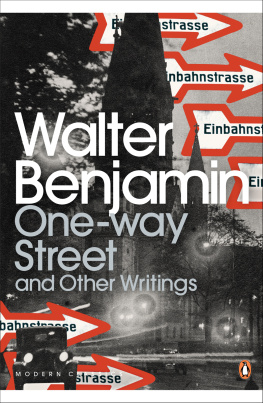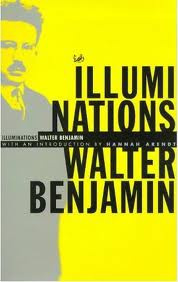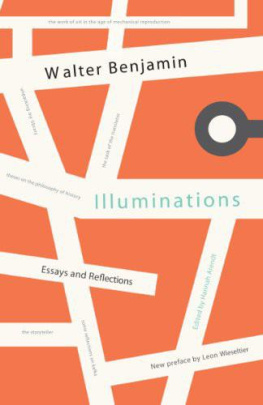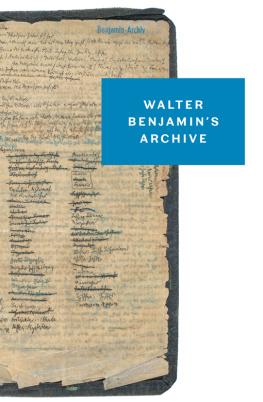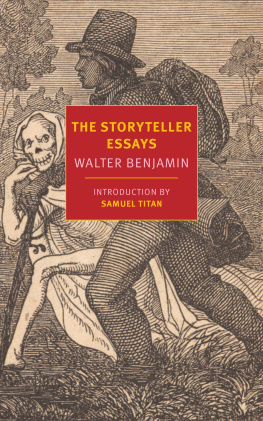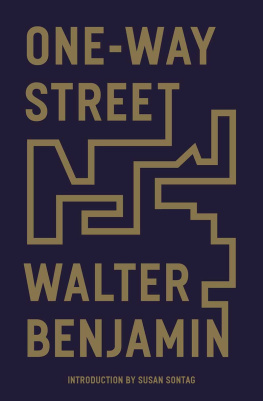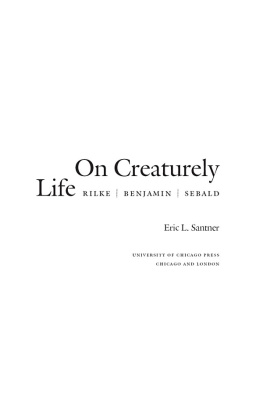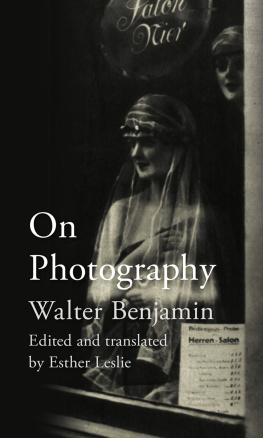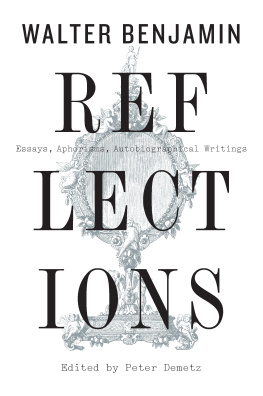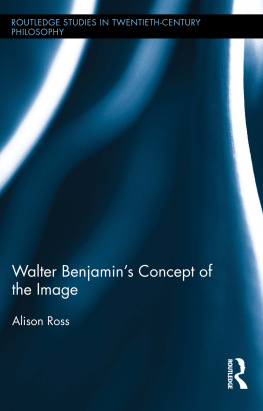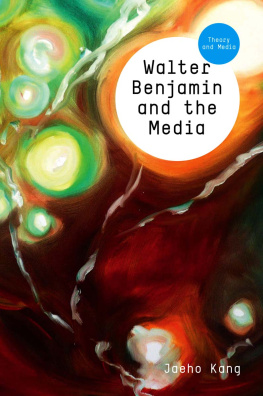Walter Benjamin - One-Way Street and Other Writings
Here you can read online Walter Benjamin - One-Way Street and Other Writings full text of the book (entire story) in english for free. Download pdf and epub, get meaning, cover and reviews about this ebook. year: 2009, publisher: Penguin Books, genre: Religion. Description of the work, (preface) as well as reviews are available. Best literature library LitArk.com created for fans of good reading and offers a wide selection of genres:
Romance novel
Science fiction
Adventure
Detective
Science
History
Home and family
Prose
Art
Politics
Computer
Non-fiction
Religion
Business
Children
Humor
Choose a favorite category and find really read worthwhile books. Enjoy immersion in the world of imagination, feel the emotions of the characters or learn something new for yourself, make an fascinating discovery.
- Book:One-Way Street and Other Writings
- Author:
- Publisher:Penguin Books
- Genre:
- Year:2009
- Rating:5 / 5
- Favourites:Add to favourites
- Your mark:
- 100
- 1
- 2
- 3
- 4
- 5
One-Way Street and Other Writings: summary, description and annotation
We offer to read an annotation, description, summary or preface (depends on what the author of the book "One-Way Street and Other Writings" wrote himself). If you haven't found the necessary information about the book — write in the comments, we will try to find it.
One-Way Street and Other Writings — read online for free the complete book (whole text) full work
Below is the text of the book, divided by pages. System saving the place of the last page read, allows you to conveniently read the book "One-Way Street and Other Writings" online for free, without having to search again every time where you left off. Put a bookmark, and you can go to the page where you finished reading at any time.
Font size:
Interval:
Bookmark:
WALTER BENJAMIN
Other Writings
Translated by J. A. Underwood
with an Introduction by Amit Chaudhuri

PENGUIN BOOKS
PENGUIN CLASSICS
Published by the Penguin Group
Penguin Books Ltd, 80 Strand, London WC2R 0RL , England
Penguin Group (USA) Inc., 375 Hudson Street, New York, New York 10014, USA
Penguin Group (Canada), 90 Eglinton Avenue East, Suite 700, Toronto, Ontario, Canada M4P 2Y3
(a division of Pearson Penguin Canada Inc.)
Penguin Ireland, 25 St Stephens Green, Dublin 2, Ireland (a division of Penguin Books Ltd)
Penguin Group (Australia), 250 Camberwell Road, Camberwell, Victoria 3124, Australia
(a division of Pearson Australia Group Pty Ltd)
Penguin Books India Pvt Ltd, 11 Community Centre, Panchsheel Park, New Delhi 110 017, India
Penguin Group (NZ), 67 Apollo Drive, Rosedale, North Shore 0632, New Zealand
(a division of Pearson New Zealand Ltd)
Penguin Books (South Africa) (Pty) Ltd, 24 Sturdee Avenue, Rosebank, Johannesburg 2196, South Africa
Penguin Books Ltd, Registered Offices: 80 Strand, London WC2R 0RL , England
www.penguin.com
On the Critique of Violence first published 1921; The Task of the Translator first published 1923; One-way Street and Hashish in Marseille first published 1928; Picturing Proust and Surrealism first published 1929; Unpacking My Library first given as a radio talk 1931; Brief History of Photography first published 1931; Franz Kafka first published 1934; The Work of Art in the Age of Mechanical Reproduction, Franz Kafka and Picturing Proust first translated and published as The Work of Art in the Age of Mechanical Reproduction in Penguin Books 2008
This selection and translation first published in Penguin Modern Classics 2009
Translation copyright J. A. Underwood, 2008, 2009
Introduction copyright Amit Chaudhuri, 2009
All rights reserved
The moral right of the translator and introducer has been asserted
Except in the United States of America, this book is sold subject to the condition that it shall not, by way of trade or otherwise, be lent, re-sold, hired out, or otherwise circulated without the publishers prior consent in any form of binding or cover other than that in which it is published and without a similar condition including this condition being imposed on the subsequent purchaser
ISBN: 978-0-14-193227-9
PENGUIN MODERN CLASSICS
One-way Street and Other Writings
Walter Benjamin was born on 15 July 1892 to a German-Jewish family in Berlin. He was educated at the Albert Ludwig University in Freiburg and the Friedrich Wilhelm University in Berlin. Benjamin considered himself a man of letters and a literary critic; he shied away from the more formal title of philosopher. An essay on Goethes Elective Affinities published in 1924 earned him swift recognition but he struggled to find a position to support himself and build on its success. In the period between 1925 and 1933 Benjamin maintained a meagre living as a literary critic, translator and freelance writer for journals and magazines. During this time he met a number of left-wing intellectuals and befriended among others Bertholt Brecht and Theodor Adorno. When the Nazis came to power in 1933, Benjamin fled to Paris and became a prominent critic of Hitlers regime. Paris served as an inspiration and it was during this period that he wrote some of his most influential essays and articles for literary journals, working on his immense study of nineteenth-century Parisian life known as The Arcades Project (which was posthumously published in unfinished form). Following the Nazi invasion of France Benjamin attempted to escape to the United States where a visa had been obtained for him. Trying to get through to neutral Portugal, Benjamin was prevented from crossing the Spanish border and committed suicide on 27 September 1940.
J. A. Underwood celebrates forty years as a freelance translator from German or French this year (2009), during which time he has been privileged to translate or retranslate books by a wide variety of authors including Elias Canetti, Jean-Paul Sartre, Franz Kafka, Alain Robbe-Grillet, Sigmund Freud, and now Walter Benjamin.
Amit Chaudhuri is a novelist, poet, critic and musician.
One must begin, as Susan Sontag did in her great essay Under the Sign of Saturn, by looking at photographs of the man. This is because, despite our curiosity and ardent interest, we know relatively little about him, and the little we know is too familiar. So we go back to the man himself, to the likeness as we sometimes study the faces of those whose lives were interrupted early, to see what they can tell us. Sontag notes that Benjamin, in 1927, at the age of thirty-five, is, with his high forehead and mustache above a full lower lip, youthful, almost handsome. His head is lowered in this picture, and the downward look through his glasses the soft, daydreamers gaze of the myopic seems to float, believes Sontag, off to the lower left of the photograph. In a picture taken after about ten years, though, Sontag finds no trace of youth or handsomeness The look is opaque, or just more inward: he could be thinking or listening There are books behind his head.
Two things strike a chord in Sontags summation, although it takes a long time to grasp what they are. The first is the portrait of the intellectual in this case, Walter Benjamin as contemporary, and contemporaneousness being a quality (bestowed on him by death) at once tragic and optimistic. Despite losing his youth and handsomeness, Benjamin will never grow old, and we are always subliminally aware of this: Benjamin, thus, never forfeits his curious unworldliness he never settles into success or hardens into conservatism, never disintegrates into infirmity or dependence. This contemporaneousness, achieved through both the texture of the work and the arc of the life, is the essence of the photographs, and gives Benjamin, despite or because of his strange life, his anomalous, friend-like status in our imaginations. It makes this, in many ways, difficult and complex writer seem oddly accessible.
This brings me to the second thing that Sontag notices almost inadvertently: the recognizability proffered by the photographs. Sontag does not approach the man in them as if he were a stranger; instead, she speaks of him with intimacy. This note of intimacy allows her to draw the portrait within the essay, which elaborates upon a single remark that Benjamin made about himself: I came into the world under the sign of Saturn the star of the slowest revolution, the planet of detours and delays Benjamins melancholic self-awareness, ironically fortified by his fatalism, draws Sontag out, in this connection, on his phantasmagorical, shrewd, subtle relation to cities, on his famous flnerie, as a theory and a practice, and even on his slowness, his blundering, his stubbornness:
Slowness is one characteristic of the melancholic temperament. Blundering is another, from noticing too many possibilities, from not noticing ones lack of practical sense. And stubbornness, from the longing to be superior on ones own terms.
In this way, Benjamin is turned, by Sontag, into a familial figure, an obscure relative whom one had largely studied from a distance, and, somewhat peremptorily, thought one knew. There might be a reason for this sense of curiosity and recognition; Benjamin might belong to a family that many of us have a relationship to.
*
When I look at Benjamins photographs, I realize now that I, too, experience that sense of recognizability which Sontag builds her argument around, and uses to her advantage, but does not explain: so subtle and integrated into the personal, into memory, is that register of affinity. When I look at Benjamins face, for instance, I realize that I do not see, first and foremost, a Western man; I see someone familiar, someone who could also have been a Bengali living at any time between the end of the nineteenth and the middle of the twentieth centuries. Certainly, the high forehead and the mustache above a full lower lip, and especially the soft, daydreamers gaze of the myopic, the features characterized not by nationality or caste but by introspection, gentility, and the privileges of childhood, mark him out as a
Next pageFont size:
Interval:
Bookmark:
Similar books «One-Way Street and Other Writings»
Look at similar books to One-Way Street and Other Writings. We have selected literature similar in name and meaning in the hope of providing readers with more options to find new, interesting, not yet read works.
Discussion, reviews of the book One-Way Street and Other Writings and just readers' own opinions. Leave your comments, write what you think about the work, its meaning or the main characters. Specify what exactly you liked and what you didn't like, and why you think so.

